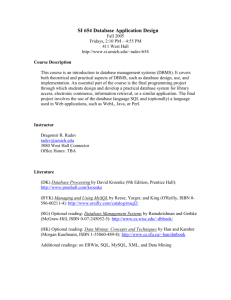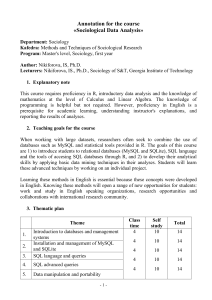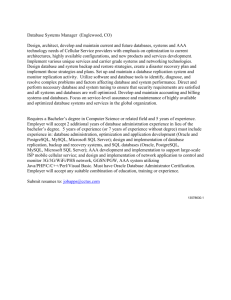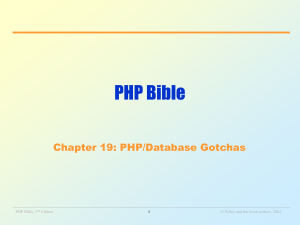SQL and programming languages
advertisement
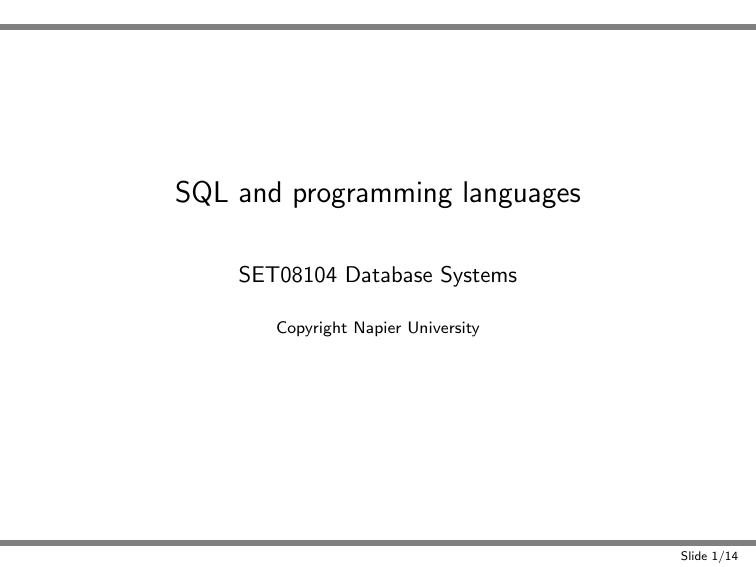
SQL and programming languages
SET08104 Database Systems
Copyright Napier University
Slide 1/14
Pure SQL
Pure SQL: Queries typed at an SQL prompt.
I
SQL is a non-procedural language.
I
SQL specifies WHAT, not HOW.
Pure SQL is good for:
I
I
I
I
I
defining database structure
generating low-volume, ad hoc queries
prototyping
Sophisticated applications are often implemented by using
SQL in combination with a programming language.
Slide 2/14
Embedded SQL
I
SQL can be embedded within procedural programming
languages.
I
These languages include C/C++, Java, Perl, Python, and
PHP.
Embedded SQL supports:
I
I
I
I
I
Highly customised applications.
Background applications running without user intervention.
Combining database tools with programming tools.
Databases on the WWW.
Slide 3/14
Two types of embedding
Low-level embedding (eg. C/C++):
I
SQL and program compiled into a single executable.
I
Very efficient link.
ODBC - Open Database Connectivity (eg. PHP/Java):
I
SQL query sent from the program to the database as a string.
I
Results returned as an array or list.
Independence of program and database:
I
I
I
Each language has one DBI (database interface) for all DBMS
types. (For example, JDBC for Java.)
Separate database drivers (DBD) for each DBMS type.
Slide 4/14
Low-level embedding (eg. C/C++)
I
Queries consist of a mixture of SQL and special commands.
I
A cursor steps through the resulting rows one at a time.
For example:
EXEC SQL SELECT empname INTO :ename
FROM employee WHERE eno = :eno;
Slide 5/14
Cursors
I
A pointer to the current item in a query result set.
I
Starts with the first item.
I
Steps through the results one at a time.
I
Some cursor implementations allow to step back up as well.
Slide 6/14
ODBC database connections
I
Connect to the database.
I
Prepare a query (as a string).
I
Execute the query.
I
Fetch the results (as an array of rows).
I
Finish the query (so that DB can clean up its buffers).
I
Disconnect from the database.
Slide 7/14
For example: Java
I
import the DBI libraries
Class.forName(”oracle.jdbc.OracleDriver”)
I
connect to the database
Connection con = DriverManager.getConnection
(”jdbc:oracle:Databasename”,”myLogin”,”myPassword”);
I
Execute a query
ResultSet rs = stmt.executeQuery
(”SELECT empno, surname FROM employee”);
I
Cursor points to the first row
rs.next()
Slide 8/14
Fetching the result (Java)
while (rs.next()) {
int emp = rs.getInt("empno");
String surn = rs.getString("surname");
System.out.println(emp + " " + surn); }
or
while (rs.next()) {
int emp = rs.getInt(1);
String surn = rs.getString(2);
System.out.println(emp + " " + surn);}
Slide 9/14
For example: PHP
I
I
I
I
I
I
connect to the database
$link = mysql connect(’hostname’,’uname’, ’passwd’);
Select database
mysql select db(’test’);
Execute a query
$result = mysql query(’select * from test’);
Fetch the result
(See next slide)
Finish the query
mysql free result($result);
Disconnect the database
mysql close($link);
mysql commands might throw errors, which should be caught:
... or die(’Error message ’ . mysql error());
Slide 10/14
Fetching the result (PHP)
echo "<table>";
while ($line = mysql fetch array($result, MYSQL ASSOC)){
echo "<tr>"; echo "<td>",$line[’firstfield’],"</td>";
echo "<td>",$line[’secondfield’],"</td>";
echo "<td>",$line[’thirdfield’],"</td>";
echo "</tr>";
}
echo "</table>";
Slide 11/14
Security Warning!
I
Using MySQL and PHP on the web is a potential severe
security risk.
I
There is a lot of nonsense information about how to use
MySQL with PHP on the web.
I
It is especially dangerous to take any user input (i.e. form
variables) and use them directly in an SQL query.
I
For an experienced programmer, PHP provides a lot of support
for writing secure code (but that is beyond this lecture).
I
Inexperienced programmers should not use MySQL with PHP.
Slide 12/14
Security Warning continued
This is a statement found in a PHP forum:
“At first my remote connection to Mysql did not work,
but then I discovered I only had to stop my firewall and it
worked fine.”
Slide 13/14
Security Warning continued
This is what a hacker might type into a textfield written by the
user on the previous slide:
0; SELECT * from mysql.user; - -
Slide 14/14


